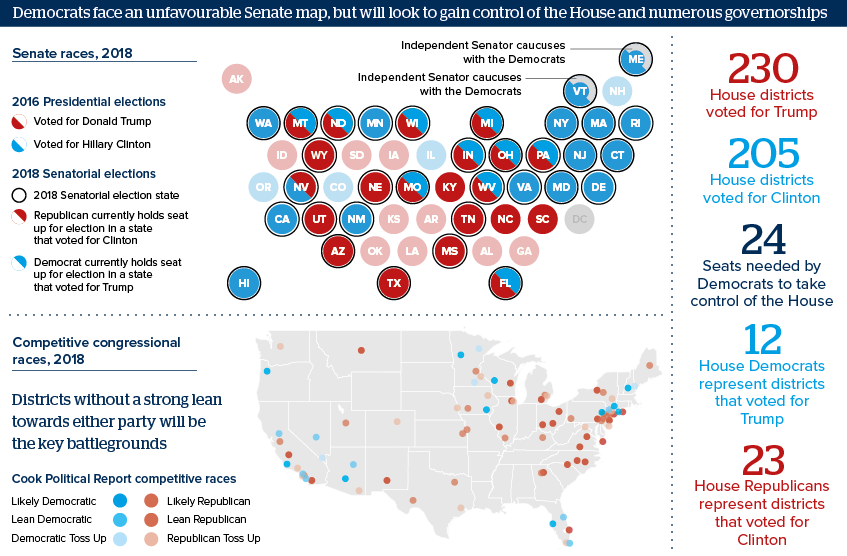Midterms will dominate US 2018 congressional politics
The midterm elections will see Republicans’ structural advantage compete with Democrats’ lead in generic polling
Source: The Cook Political Report, US Senate, US House of Representatives, BBC, Vox, Oxford Analytica
Outlook
In November, 33 of the 100 US Senate seats face re-election, and all 435 House of Representatives seats. The votes will be the first nationwide indication of public sentiment since Donald Trump was inaugurated president, though local issues will also be important.
The Democrats have the lead in generic polling, but current seat boundaries could disadvantage them. Equally, an above average number of incumbent Republicans have said already they are not seeking re-election, diluting the advantage of incumbency. Both parties could suffer in ‘mismatched’ districts where the representative’s party differs from how the state voted in the 2016 presidential election.
Impacts
- If the Democrats win at least one congressional house, policy gridlock will be likely.
- A Democratic House or Senate would increase scrutiny on the White House, including over election-related controversies.
- Even with Congress majorities, Republicans will find agreement on areas such as welfare reform and infrastructure development elusive.
- The 33 governors’ races will greatly influence issues ranging from education to minimum wages and healthcare.
See also
- Both main US parties lost and won overnight - Nov 7, 2018
- Prospects for US politics to end-2018 - Jun 14, 2018
- US vote ruling could hit parties’ vote strategies - Jun 12, 2018
- US CIA is not yet immune from political pressure - Jun 11, 2018
- US Congress will roll back post-2008 bank regulation - Apr 11, 2018
- Trump will tilt further towards US religious right - Apr 3, 2018
- US-North Korea summit would have modest outcome - Mar 9, 2018
- Lobbying could increase US populism - Feb 20, 2018
- US executive privilege battle could be coming - Feb 7, 2018
- New tax law will help US energy sector - Feb 1, 2018
- US Congress will take policy lead in 2018 - Jan 31, 2018
- US Democrats cannot assume their resurgence - Jan 12, 2018
- Slim majority will test US Republicans - Jan 8, 2018
- More graphic analysis
